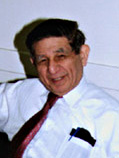An Introduction to Quantum Computing
Category
Published on
Abstract
Quantum mechanics, as formulated more than 80 years ago by Schrodinger, Heisenberg, Dirac and other greats, is a wholly sufficient foundation for its modern interrelated subfields of quantum computation (qc) and quantum information (qi), which generally are lumped together into a single subfield (qc/qi). In short qc/qi, though it has been exciting the attention of a very rapidly increasing number of physicists, involves no genuinely new physics. On the other hand some of the important features and implications of quantum mechanics had been only barely appreciated before the advent of qc/qi researches, about 25 years ago. The first portion of this talk will define the fundamental qc component, namely the qubit, and will describe some possible physical realizations of qubits. The talk then will focus on one alluded-to feature (entanglement) and one implication (the so-called no cloning theorem), which for unfathomable reasons still receive little or no attention in modern quantum mechanics texts. The talk will close with an explanation (as detailed as time permits) of how a qc computation actually is performed. This explanation will involve pertinent brief references, but no more than brief references, to the so-called Shor factoring algorithm, which provides the best known illustration of the potential power of qc; an adequate explication of Shor’s algorithm would require a full colloquium in itself. My entire talk should be quite comprehensible to any graduate student who has taken an introductory course in quantum mechanics, even if only at the undergraduate level.
Bio
 Edward Gerjuoy received his Ph.D. in theoretical physics from the University of California at Berkeley in 1942. After working on antisubmarine warfare problems during World War II he taught at several academic institutions, winding up at the University of Pittsburgh where he presently is Professor of Physics Emeritus, having been appointed professor in 1964. In 1977 he obtained a law degree, and thereafter for many years shared his time between physics and the law. As a scientist lawyer he has been Editor-in-Chief (1981-1986) of the American Bar Association (ABA) Journal of Law, Science and Technology. During his entire career, however, he also has devoted considerable time to the defense of human rights. In particular, he has several times served as Chair of the American Physical Society Committee on the International Freedom of Scientists, the APS human rights committee; he also was a member of the legal team that successfully defended Los Alamos scientist Wen Ho Lee against government charges of mishandling classified documents with the intent to injure the United States. He terminated his legal activities about five years ago, however, and since then has been devoting his full time to research on quantum computing theory. He is the author of over 100 papers in the physics literature, mainly on atomic collision theory, and about 30 papers on various physics and public policy topics.
Edward Gerjuoy received his Ph.D. in theoretical physics from the University of California at Berkeley in 1942. After working on antisubmarine warfare problems during World War II he taught at several academic institutions, winding up at the University of Pittsburgh where he presently is Professor of Physics Emeritus, having been appointed professor in 1964. In 1977 he obtained a law degree, and thereafter for many years shared his time between physics and the law. As a scientist lawyer he has been Editor-in-Chief (1981-1986) of the American Bar Association (ABA) Journal of Law, Science and Technology. During his entire career, however, he also has devoted considerable time to the defense of human rights. In particular, he has several times served as Chair of the American Physical Society Committee on the International Freedom of Scientists, the APS human rights committee; he also was a member of the legal team that successfully defended Los Alamos scientist Wen Ho Lee against government charges of mishandling classified documents with the intent to injure the United States. He terminated his legal activities about five years ago, however, and since then has been devoting his full time to research on quantum computing theory. He is the author of over 100 papers in the physics literature, mainly on atomic collision theory, and about 30 papers on various physics and public policy topics.
His quantum computing/information publications include:
- “Deterministic Dense Coding and Entanglement Entropy” (with P.S. Bourdon, J. P. McDonald and H.T. Williams), Phys. Rev. A77, 22305-1 thru 16 (2008).
- “Popper’s Experiment and Communication” (with Andrew Sessler), a “Note and Discussion,” Am. J. Phys. 74, 643-648 (2006).
- “Shor’s Factoring Algorithm and Modern Cryptography. An Illustration of the Capabilities Inherent in Quantum Computers, Am. J. Phys. 73, 521-540 (2005).
- “Lower bound on entanglement of formation for the qubit-qudit system,” Phys. Rev. A67, 52308-1 thru 10 (2003).
Sponsored by
Condensed Matter and Biological Physics Seminar, Purdue University
Cite this work
Researchers should cite this work as follows:
Time
Location
Physics 223, Purdue University, West Lafayette, IN